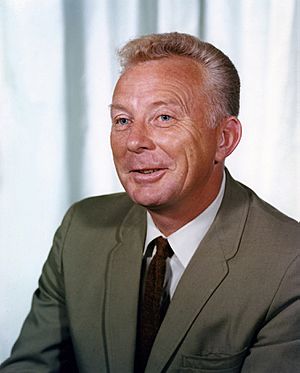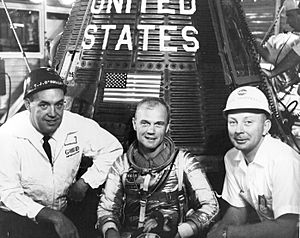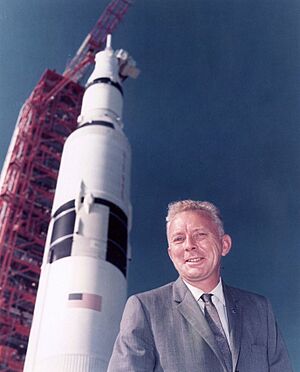Paul C. Donnelly facts for kids
Quick facts for kids
Paul C. Donnelly
|
|
|---|---|

Official NASA portrait, 1969
|
|
| Born | March 28, 1923 |
| Died | March 12, 2014 (aged 90) |
| Known for | Apollo launch operations management |
| Awards | NASA Distinguished Service Medal (2) NASA Exceptional Achievement Medal (3) NASA Outstanding Leadership Medal |
| Scientific career | |
| Fields | Guided missiles, electrical engineering |
| Institutions | 1942–45: National Hydraulic Lab 1946–58: Navy Bur. of Ordnance |
| Influences | Hugh L. Dryden |
| Influenced | George Page, Robert Sieck |
Paul Charles Donnelly (March 28, 1923 – March 12, 2014) was an important American engineer. He helped create early guided missiles and was a top manager at NASA. He worked at the Kennedy Space Center (KSC) during the exciting Apollo Moon landing program.
Paul Donnelly was in charge of checking all the Apollo rockets and spacecraft before they launched. He was also involved in almost every U.S. space launch with astronauts. This included flights from Alan Shepard's first trip into space in 1961 to a Space Shuttle mission in 1984.
During World War II, Donnelly helped develop the U.S. Navy's "Bat" bomb. This was the first "smart bomb" ever used in war. His Navy team used these bombs against Japanese ships in 1945.
Contents
Who Was Paul C. Donnelly?
Paul Donnelly was born on March 28, 1923, in Altoona, Pennsylvania. His father was an Irish immigrant, and his mother was born in Germany. He finished high school in 1940 and later received an award from his old school in 2000.
In 1942, he joined the Navy and studied electronics. He also went to special Navy schools for electronics and guided missiles.
Early Life and War Hero
Because of his red hair, Paul was nicknamed "Red." He worked in Washington, D.C., at the National Bureau of Standards. There, he helped develop secret guided weapons, including the Bat bomb. This work took place at the Navy's National Hydraulic Laboratory.
On April 28, 1945, his squadron, known as the Bat Squadron, used the first fully automatic (radar) guided bombs in battle. They dropped several SWOD-9 Bat bombs on Japanese ships in Borneo. This attack sank three ships and destroyed a large oil tank. Donnelly became a chief petty officer and earned nine Navy medals.
After the war, Donnelly continued to work for the Navy as a civilian. He tested aircraft and weapons at different Navy stations. It was there that he met future astronauts like Alan Shepard, Pete Conrad, and John Young. In 1951, he earned an electronic engineer-equivalent degree.
Working with NASA
Paul Donnelly had worked with Hugh L. Dryden, who later became NASA's deputy administrator. In 1958, Dryden recommended Donnelly to Robert R. Gilruth, who was in charge of NASA's Space Task Group. Gilruth hired him.
In 1959, Donnelly moved to Cape Canaveral, Florida. He became a test conductor for all the Project Mercury and Gemini launches. This meant he was in charge of testing the spacecraft before they flew.
Later, he became the chief test conductor for the Gemini program in Florida. He was responsible for planning and directing all the tests before manned spacecraft launched.

In 1964, he became the launch operations manager for KSC. He oversaw both the spacecraft and the rockets. He reported to Rocco Petrone, who was the director of launch operations at KSC.
On January 27, 1967, a fire broke out in the Apollo 1 command module, killing the crew. Donnelly was the launch operations manager that day. He later helped with the investigation into the accident.
As the launch operations manager during the Apollo program, he was responsible for checking all manned space vehicles. This included the rockets and spacecraft, from Apollo 7 in 1968 through the Apollo-Soyuz Test Project in 1975. By 1973, he became an associate director of launch operations.
In 1976, Donnelly managed a science and technology display at KSC. This display celebrated the U.S. Bicentennial. In 1977, he led a NASA team that performed "drop tests" of the Space Shuttle Enterprise. These tests helped prepare the Space Shuttle for flight.
After NASA
In 1978, Donnelly retired from NASA. He then joined United Space Boosters, Inc. (USBI) as a vice president. This company was responsible for assembling and preparing the Space Shuttle Solid Rocket Boosters. He retired from USBI in 1989.
Donnelly was a leader in several space organizations. He was a trustee and former president of the Missile, Space and Range Pioneers. He also helped start and chaired the Astronauts Memorial Foundation. He received a Lifetime Achievement Award from the National Space Club.
Paul Donnelly passed away on March 12, 2014, at the age of 90.
Family Life
Paul Donnelly married Margaret Mary Boyle in 1944. She was a nurse. They had three daughters: Penelope, Pamela, and Paula. They also had nine grandchildren and four great-grandchildren. Paul had 12 brothers and sisters.
Awards and Recognition
Paul Donnelly received six important medals from NASA for his work:
- Two Distinguished Service Medals (in 1973 for the Apollo program, and in 1981 for the first Space Shuttle mission).
- Three Exceptional Achievement Medals (in 1969 for Apollo 8, in 1969 for Apollo 11, and in 1978 for Space Shuttle tests).
- One Outstanding Leadership Medal (in 1976 for his work on the Bicentennial display).
|
|
| NASA Distinguished Service Medal with oak leaf cluster | NASA Exceptional Achievement Medal with two oak leaf clusters | NASA Outstanding Leadership Medal |


